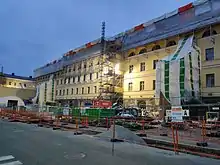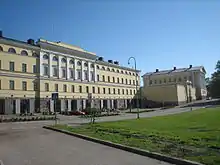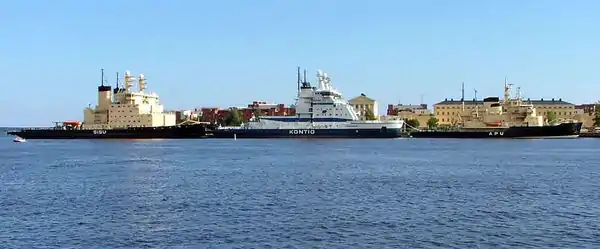Merikasarmi
Merikasarmi (originally known as Katajanokan kasarmi) is a barracks building in Katajanokka, Helsinki, Finland, originally built for the military of the Empire of Russia from 1816 to 1820,[1] which currently houses the premises of the Ministry for Foreign Affairs in Finland. The barracks was designed by Carl Ludvig Engel. Before the Foreign Ministry moved to the area in the late 1980s the buildings were renovated and partly rebuilt according to the plans of Professor of Architecture Erik Kråkström.

To the north of the Merikasarmi building, the icebreakers of the Finnish state are anchored to the Katajanokka quay.
History
Project of the Empire of Russia
The Merikasarmi building is located on the northern shore of Katajanokka near the edge of the Katajanokka peninsula. There was an artillery battery situated in Katajanokka at the site of the current Katajanokka Casino already in 1721 during the Treaty of Nystad. There was artillery in Helsinki especially in Viapori. In 1812 the artillery area was decided to be used as the base of a barracks.[2] The main zoning plan for the city of Helsinki was made by Johan Albrecht Ehrenström.
The building was financed by the Empire of Russia by order of Alexander I of Russia in 1816. Carl Ludvig Engel arrived in 1816 to plan the building, and after three months it was ready to be shown to Nicholas I of Russia. In 1826 two additional wings were ordered: a kitchen wing and a dormitory wing for officers. These wings were mostly finished by 1838. The wing on the western edge of the barracks was completed in 1825, but the eastern wing designed by Engel was not built at this point. There were Orthodox worships held during the early years of the Katajanokka barracks. The first soldiers to move to the barracks represented the ground forces of the military of the Empire of Russia.
From Katajanokka barracks to marine barracks
In 1832 the barracks was transferred to the use of the navy of the Military of the Grand Duchy of Finland, founded two years earlier.[1] Because of this, the Katajanokka barracks was now called "Merikasarmi" (literally "marine barracks"). The navy of the military of the Grand Duchy of Finland was disbanded in 1880, when the army of the military was changed from a professional army to a drafted army. This caused the barracks to return to Russian use, and the area became a strong base for the Baltic Fleet.[1] The Governors-General of the Grand Duchy of Finland thought the atmosphere of the Katajanokka barracks was unhealthy for Russian soldiers.
After Finnish independence

After Finland became independent, the Merikasarmi building was transferred use for the Finnish Navy. The command of the navy was present in the area until 1958. The building was in use for the Guard Jaeger Regiment until 1968, when the regiment moved to Santahamina and Taivallahti.[3]
In 1972 the Finnish Government decided to take the building into use for the Ministry for Foreign Affairs, but this only happened in the late 1980s. The last military institutions present in the area were the electrical and messaging departments of the Defence Command from 1980 to 1985.[4] Valmet, founded after World War II, had its docks in the area and moved from Merikasarmi to Vuosaari in 1975.[5]
A large area at the eastern tip of the Katajanokka peninsula was in use for the navy and later Valmet. There were a group of brick and wooden maintenance and storage buildings around the barracks proper. After the dock had moved away from the area, a residential area was built to the south and east of the barracks, known as the "new side" of Katajanokka. A number of the old brick buildings to the west of the barracks was preserved, one of them houses the Katajanokka elementary school.
The Ministry for Foreign Affairs moved to Merikasarmi from 22 different premises all around Helsinki between January 1986 and September 1989.
The inner courtyard between the C and G buildings of Merikasarmi was named Martti Ahtisaaren aukio ("Martti Ahtisaari Square") after President of Finland Martti Ahtisaari in 2009. The original purpose of the square had been to serve as an exercise field and ceremony courtyard for the Russian military.[6]
The largest renovation in the history of the building started in November 2018. The purpose of the renovation is to make the premises more modern and more suitable for office use, and the entire building services engineering is under reconstruction. After the renovation the building will have space for over 800 employees in contrast to 400 as before. The renovation has been commissioned by Senate Properties and is being carried out by NCC.[7] The approximate cost of the renovation is 88 million euro.[8]
Users of the barracks
- Military of the Empire of Russia stationed in Helsinki from 1820 to 1832
- Navy of the Military of the Grand Duchy of Finland from 1832 to 1880[4]
- The Baltic Fleet from 1880 to 1917[1]
- Navy of Finland from 1918 to 1959[4]
- The Guard Jaeger Regiment from 1958 to 1968[4]
- The electrical and messaging departments of the Finnish Defence Command from 1 June 1980 to 30 April 1985[4]
- The Ministry of Foreign Affairs in Finland starting from 1986-1989
Buildings
Merikasarmi is an architecturally significant complex of several buildings, named A, B, C, D, E, F, G, and H. Some of the buildings are original buildings from the 19th century, some have been built later in accordance of the appearance of previously built buildings.
Building A

The main building of Merikasarmi, building A, was previously called Matruusirakennus.[9] It was built in 1820.[5]
The A building is located on the Laivastokatu street parallel to the Katajanokka quay. The mailing address for all buildings in the Ministry of Foreign Affairs is Laivastokatu 22.
Ritarikatu hall
The Ritarikatu hall is the auditorium of Merikasarmi, used for long information sessions. In the waiting hall of the Ritarikatu hall there is a street sign saying Ritarikatu, depicting the location of the ministry's former premises at the easternmost wing of the Government Palace on Ritarikatu street.
Engel hall
The Engel hall is a basement hall, the inside of which has red bricks reminiscent of a basement restaurant. It is easy to enter from the icebreaker side, through large glass doors on the northern shore side of Katajanokka. The hall is used for large information sessions.
Second floor
The second floor hosts the office of the Minister of Foreign Affairs, the office of the Secretary of the State and the office of the command of the political department.
Third floor
The third floor hosts the office of the minister for European and foreign trade and part of the offices of foreign economic relations.
Main corridor
The main corridor hosts offices of the command of the ministry. The narrow corridor is lit by functionalist lamps.[10]
On the western end of the corridor are the pictures of Finnish Ministers of Foreign Affairs and a sculpture of a bird.
There was formerly a company hall on the third floor, used for indoor foot drills for the military. The idea was to save the soldiers from the cruel marine weather during the drills. Governors-General Fabian Steinheil and Arseny Zakrevsky were worried about the health of the soldiers. Carl Ludvig Engel designed an efficient system of heating, so that according to him, even during a winter of -30 degrees Celsius the indoor temperature was "so terribly hot I thought I was dying".[2]
Building B (eastern curtain wall rooms)

To the east of the main building is the building for eastern curtain wall rooms,[2] with the judicial department and library of the Ministry of Foreign Affairs. The B building was already part of Engel's original plan, but was left unbuilt at the time. When the area was renovated to its current shape in the 1980s the B building was built in accordance of Engel's original plan, similar to the H building, so it completes the symmetry of the north-facing facade of the A and B buildings.
The library of the Ministry of Foreign Affairs is located to the east of the northern buildings as is the judicial department. The library has approximately 30 thousand books and twelve shelf kilometres' worth of material starting from 1918. The normal period of secrecy of the documents is 25 years. The library is open to the public during business hours and books can be loaned with proof of identity and contact details.
Building C
Building C is a north-south building on the eastern side of Merikasarmi easily identifiable by the two large Yagi–Uda antennas on top of its roof, which can be used to receive radio messages from abroad. Building C is connected to the former hospital building, currently known as building E, with building D along Merikasarmikatu.
Building D
Building D connects buildings C and E. It is located along Merikasarmikatu.
Building E (hospital)
The hospital building of Merikasarmi was built in 1838.[11] It is located along Merikasarmikatu.
Building E is connected to building G by building F on the western side and to building C on the eastern side by building D.
Building F
Building F connects the hospital building to building G. The buildings F, E and D are located in a row built next to each other along Merikasarmikatu.
Building G
Building G hosts the unit for EU expansion and the West Balkan of the Europe department, the Eastern department, and part of the department for foreign economic relations.[12] Building F connects building G to the hospital building E. Building G hosts the Ehrensvärd space where ambassadors visiting Finland hold a common session before returning to their position countries.
Building H (western curtain wall rooms, officer building)
The western curtain wall room[5] building hosts the Europe department of the Ministry of Foreign Affairs. The building was built in 1825 for use for army officers. The building hosted the command of the Finnish Navy until 1958.[5]
Building H is located in the corner of Laivastokuja and Laivastokatu.
Other information
Traffic connections
The Merikasarmi building can be reached by the Helsinki tram line 4 from the centre of Helsinki.
In art
- Valerian Galjamin: Näkymä Pohjoisrannasta Katajanokalle ("A view from Pohjoisranta to Katajanokka"), watercolour, 1827[13]
- Part of the film Meidän poikamme merellä "(Our boys at the sea") was filmed at Merikasarmi. The film was the most popular film in Finland during the great depression of 1933.[10]
References
- Kaija Ollila, Kirsti Toppari: Puhvelista Punatulkkuun, Helsingin vanhoja kortteleita, pp. 308-309. Sanoma Oy, 1998. ISBN 951-9134-69-7.
- Ulkoasiainministeriö: Artikkeleita Katajanokan historiasta - Taidehistoriaa Katajanokalla
- Helsinki kehyksissä - Katajanokka - Hökkelikylästä kivikaupungiksi - Merikasarmi
- Plaques on the wall of the Merikasarmi building
- Ulkoasiainministeriö: Artikkeleita Katajanokan historiasta - Kuvat kertovat Merikasarmin historiasta
- Martti Ahtisaarelle aukio Katajanokalle
- Ylväs Merikasarmi uudistuu moderniksi monitilaympäristöksi, Senate Properties 28 May 2019. Accessed on 28 July 2019.
- Ulkoministeriön Merikasarmi peruskorjataan – kustannusarvio 88 miljoonaa euroa, Ilta-Sanomat 6 September 2018. Accessed on 28 July 2019.
- K. Avellan & M. Nissinen: Strengthening and underpinning the foundations of the main building of the Ministry of Foreign Affairs of Finland
- Ulkoasiainministeriö: Artikkeleita Katajanokan historiasta - Vakoiludraaman sivunäytös Merikasarmilla
- Kohde id:200260 Merikasarmi LUONNOS - SISÄLTÖ VARMENTAMATON: Sairaalarakennus
- Ulkoasiainministeriö: EU:n laajentumisen ja Länsi-Balkanin yksikkö: tehtävät
- Picture
Bibliography
- M. Favorin and K. Ristolainen, The Naval Barracks = Merikasarmi, 1993, Ministry for Foreign Affairs, Helsinki
- E. Kråkström, Katajanokka Merikasarmi. Naval Barracks, Ministry of Foreign Affairs of Finland, unpublished
- Engel: Plan de la nouvelle Caserne pour Helsingfors (Plan for new barracks in Helsinki), online version (PDF)